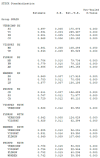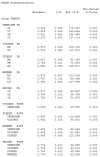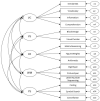Cross-National Generalizability of WISC-V and CHC Broad Ability Constructs across France, Spain, and the US
- PMID: 37623542
- PMCID: PMC10455271
- DOI: 10.3390/jintelligence11080159
Cross-National Generalizability of WISC-V and CHC Broad Ability Constructs across France, Spain, and the US
Abstract
The Cattell-Horn-Carroll (CHC) model is based on psychometric cognitive ability research and is the most empirically supported model of cognitive ability constructs. This study is one in a series of cross-national comparisons investigating the equivalence and generalizability of psychological constructs which align with the CHC model. Previous research exploring the cross-cultural generalizability of cognitive ability measures concluded that the factor analytic models of cognitive abilities generalize across cultures and are compatible with well-established CHC constructs. The equivalence of the psychological constructs, as measured by the Wechsler Intelligence Scale for Children-Fifth Edition (WISC-V), has been established across English-speaking samples. However, few studies have explored the equivalence of psychological constructs across non-English speaking, nationally representative samples. This study explored the equivalence of the WISC-V five-factor model across standardization samples from France, Spain, and the US. The five-factor scoring model demonstrated excellent fit across the three samples independently. Factorial invariance was investigated and the results demonstrated strict factorial invariance across France, Spain, and the US. The results provide further support for the generalizability of CHC constructs across Western cultural populations that speak different languages and support the continued use and development of the CHC model as a common nomenclature and blueprint for cognitive ability researchers and test developers. Suggestions for future research on the CHC model of intelligence are discussed.
Keywords: Wechsler Intelligence Scale for Children-Fifth Edition; confirmatory factor analysis; construct validity; intelligence; measurement invariance.
Conflict of interest statement
C.J.W., L.-C.V., A.H., & L.G.W. were involved in the research and development of the Wechsler Intelligence Scale for Children, Fifth Edition, as employees of Pearson.
Figures




References
-
- AERA. APA. NCME . Standards for Educational and Psychological Testing. American Educational Research Association; Washington, DC: 2014. [(accessed on 4 December 2022)]. Available online: https://www.testingstandards.net/
-
- Agelink van Rentergem Joost A., Vent Nathalie R. de, Schmand Ben A., Murre Jaap M. J., Staaks Janneke P. C., Consortium Andi, Huizenga Hilde M. The Factor Structure of Cognitive Functioning in Cognitively Healthy Participants: A Meta-Analysis and Meta-Analysis of Individual Participant Data. Neuropsychology Review. 2020;30:51–96. doi: 10.1007/s11065-019-09423-6. - DOI - PMC - PubMed
-
- Bentler Peter M., Chou Chih-Ping. Practical issues in structural modeling. In: Long J. Scott., editor. Common Problems/Proper Solutions. Sage; Thousand Oaks: 1988. pp. 161–92.
-
- Bollen Kenneth A., Davis Walter R. Two rules of identification for structural equation models. Structural Equation Modeling. 2009;16:523–36. doi: 10.1080/10705510903008261. - DOI
-
- Bontempo Daniel E., Hofer Scott M. Assessing factorial invariance in cross-sectional and longitudinal studies. In: Ong Anthony D., Van Dulmen Manfred H. M., editors. Oxford Handbook of Methods in Positive Psychology. Vol. 13. Oxford University Press; Oxford: 2007. pp. 153–75.
LinkOut - more resources
Full Text Sources

